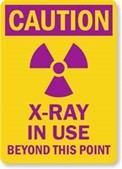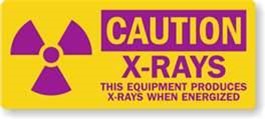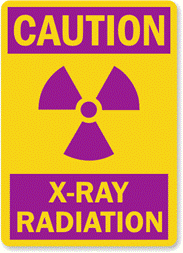2.1 Specific Considerations
Devices intended to produce X-rays are required to be licensed by the Federal, State and/or local jurisdictions. New devices must be included on a site license prior to operation. X-ray devices present risk of exposure to radiation and must be carefully managed.
Any radiation-producing machine such as a neutron generator, Vann de Graaff accelerator, or an ion source that can directly or indirectly produce ionizing radiation must be approved by the RSO prior to use. X-ray devices which have not been pre-approved and received an initial assessment of risk process are expressly prohibited from being brought onto Microsoft property.
Reading this program does not qualify the reader to work with X-rays. Guidelines that are beyond the scope of this document will be established by the RSO on a case-by-case basis. This document is not to be construed as a synopsis of all ionizing radiation requirements.
Medical X-ray equipment not specifically used on humans are classified as industrial equipment and must be operated fully enclosed, except when granted a formal variance by the RSO.
Electron microscopes, ion implanters, electron spectroscopy for chemical analysis (ESCA), photoemission X-ray spectrometers, and X-ray photoelectron spectrometers (XPS) do not emit X-rays beyond their designed function and are usually designed to prevent such emissions on an incidental basis. Thus, they are not usually considered radiation-producing machines. If such a device is suspected of emitting X-rays, it must be brought to the attention of the RSO, who will evaluate it and determine what provisions must be made for safe use.
2.2 Regulatory Requirements
Regulations applicable to X-Ray Safety may vary depending on federal, state and local jurisdictions. For more information on the regulations affecting X-Ray Safety at a specific location, contact the Site Administrator.
2.2.1 Prevention and Control
2.2.2.1 Site Specific Radiation Control Plan
Each Microsoft location that utilizes X-ray equipment must develop and implement a Site Radiation Safety Plan that is available to all employees, external staff and to federal, state or local inspectors. The site-specific requirements must be in compliance with federal, state and local regulations.
All Site Plans should include the following:
- Program purpose and scope.
- Site-specific regulatory requirements.
- Personnel roles and responsibilities.
- A Safety Plan Administrator must be designated for each work area to oversee implementation of Site Plan.
- Definitions of terms critical to an understanding of the Site Plan, or those terms not commonly understood, including but not limited to the definitions located in the definitions section of the Radiation Safety Program.
- Inspection records for X-ray systems located on site.
- General safety rules.
- PPE requirements and completed Risk Assessments.
- Identification, by name, of qualified employees who are authorized to perform work with X-rays at the site level.
- Completed annual interlock test documentation for all X-ray devices.
- Dosimetry requirements.
- nstructions stating that the RSO and the Site Administrator must be notified if an X-ray device is moved, transferred, or altered.
- Site-specific training on emergency response procedures:
- Documentation of First Aid/CPR trained employees.
- Training on response to someone who has been exposed to a radiation leak.
- Locations of emergency disconnect devices.
- Incident investigations for all accidents, incidents, and near-misses that were directly or indirectly related to X-rays.
2.3 Risk Assessment
The Plan Administrator, in conjunction with the RSO, shall assess the workplace to develop a current listing of the potential hazard areas, activities, or processes associated with X-rays to assure that the appropriate area classifications have been identified. Assessments must be reviewed and amended as necessary when processes, equipment or facilities are added or modified that can create or change the risks and hazards associated with X-ray systems. This analysis will provide a mechanism for defining work area specific hazards associated with X-rays and create a plan for hazard mitigation and employee training
The Plan Administrator, in conjunction with the RSO, shall assess the workplace to develop a current listing of the potential hazard areas, activities, or processes associated with X-rays to assure that the appropriate area classifications have been identified. Assessments must be reviewed and amended as necessary when processes, equipment or facilities are added or modified that can create or change the risks and hazards associated with X-ray systems. This analysis will provide a mechanism for defining work area specific hazards associated with X-rays and create a plan for hazard mitigation and employee training.
X-ray machines are a subset of a much broader category of radiation-producing machines. It is possible to generate X-rays intentionally or accidentally. Users must understand and account for the possibility that any device that combines high voltage and a metal target can cause X-rays.
Any electronic device capable of producing an X-ray field should be brought to the attention of the RSO, who will perform an evaluation of the hazards. The RSO will recommend and implement controls on a case-by-case basis. For equipment designed and built at Microsoft, the RSO must be included in all phases of the design process so that safety needs may be predicted to the extent possible and protective measures employed as an integral part of the design. The goal will be to make the device as intrinsically safe as reasonably achievable with no detectable X-ray fields outside of the X-ray source. If this goal can be achieved, the device will not be considered a radiation-producing machine, and no additional radiation safety controls will be required.
For equipment designed and built at Microsoft, the RSO must be included in all phases of the design process so that safety needs may be predicted to the extent possible and protective measures employed as an integral part of the design. The goal will be to make the device as intrinsically safe as reasonably achievable with no detectable X-ray fields outside of the X-ray source. If this goal can be achieved, the device will not be considered a radiation-producing machine, and no additional radiation safety controls will be required.
2.4 Dosimetry
Dosimeters to all Microsoft employees that use X-ray equipment and could receive a whole-body dose if they might receive a dose greater than 100 mrem per year. External staff must be issued dosimeters by the responsible Microsoft Lab or Facility manager.
All radiation workers (employees and external staff) must wear their dosimeters as specified in the Site Plan. Workers who might be exposed to radiation while working at other facilities will be issued dosimeters by those facilities. Dosimeters worn at Microsoft sites must not be used to monitor occupational radiation exposures at other facilities. An investigation will be performed if there is any exposure exceeding any of the administrative control levels.
The whole-body dosimeter shall be worn on the upper torso, where it will give the best estimate of the whole-body dose equivalent. Standard practice is to wear a dosimeter between the neck and the waist, but in specific situations such as non-uniform radiation fields, special considerations may apply. Some dosimeters have a required orientation with a specific side facing out. Thermoluminescent dosimetry (TLD) badges must be worn with the label facing outward. Users must take care throughout the shift that the dosimeter remains facing outward, and not covered by clothing or other PPE.
The dosimeter must not be worn during non-occupational activities, such as when undergoing medical or dental X-rays, nuclear medical procedures, radiation therapy, or during air travel. The dosimeter should only be worn in the work area and should be stored in a place specified in the Site Plan away from radiation sources. Notify the Plan Administrator and RSO immediately if non-occupational radiation exposures occur to a dosimeter, or if exposed to radiation at another facility or if the dosimeter is lost.
Personnel are responsible for following procedures specified in the Site Plan for returning their dosimeters. Managers/Supervisors are responsible for enforcing this procedure. Personnel must immediately report a lost or stolen badge to the Plan Administrator or the RSO.
Personnel who do not return their dosimeters during the prescribed period will receive a notice to do so form the Lab or Facility Manager. Continued failure to return the dosimeters will result in notification to the RSO and the worker will be removed from any radiation work until an evaluation of the employee’s work practices has been completed.
Dosimeters will be analyzed by a qualified supplier and results will be communicated to the dosimeter wearer. Any over exposures will be investigated internally by the RSO and may be reported to the local Department of Health if required by law. See the Site Plan for specific information
2.5 Health Effects and Exposure Controls
Any living tissue in the human body can be damaged by X-rays in a unique manner. In general, the amount and duration of radiation exposure affects the severity or type of health effect. Cells that are dividing are at the highest risk for damage from X-rays. Pregnant women, in first trimester of gestation, are highly sensitive to the effects of radiation.
Overexposure to X-rays can cause burns, cataracts, and other cellular mutations. As such, it is important to follow all defined safety control measures. If an exposure is suspect or any health effects are noticed after working with X-ray equipment, and incident report should be filed with Microsoft OHS, who will contact CELA, and Benefits immediately.
Once the investigation of the incident is complete, communication of the results of the investigation will be shared with those groups with similar hazards or risks.
2.5.1 Special Populations
No one under 18 years old should be employed in, or be allowed to enter, any Radiological Area (e.g., Radiation Area, Contamination Area) or work with radioactive material where they can receive a total greater than or equal to 100 mrem per year from both internal and external doses.
If planning a pregnancy, employees should seek advice from a primary licensed health care provider (PLHCP). If an employee becomes pregnant, they are strongly encouraged to declare their pregnancy in writing to the Microsoft OHS as the RSO. The allowed dose for the pregnant employee must remain ALARA during the nine months of pregnancy. The dose limit for a declared pregnant worker is 500 mrem during the term of pregnancy, with no more than 50 mrem per month.
The dose equivalent received by members of the public during direct on-site access shall not exceed 100 mrem per year based on the sum of both internal and external doses.
2.5.2 Time
Minimize the time in areas where X-rays are present. The amount of exposure occurs as a function of duration of exposure; where less time means less exposure. Time reduction can be achieved in a number of ways.
Training – knowledge on how to properly and safely work with radiation sources.
Planning – having all the proper tools and equipment needed ready ahead of time.
Dry runs – practice all of the steps that will be followed before the actual work begins
2.5.3 Distance
Maximize the distance from the radioactive materials. Dose is inversely proportional to distance, therefore, greater distance means less dose. Do not increase the distance to the point wherein dexterity or control of the materials is jeopardized.
2.5.4 Shielding
Use shielding wherever it is necessary to reduce or eliminate exposure. By placing an appropriate shield between the radioactive source and the worker, radiation is attenuated and exposure may be completely eliminated or reduced to an acceptable level. The type and amount of shielding needed to achieve a safe working level varies with the type and quantity of radioactive source used. The HVL (half-value layer) may be used as a guide to the thickness of the shielding necessary to block the radiation. The HVL is the thickness of the shielding necessary to reduce the radiation dose rate to half of the original or unshielded dose rate.
2.5.5 Personal Protective Equipment
PPE requirements will be specified in the SOP for the specific piece of equipment and based off an exposure assessment. PPE may include:
Leaded aprons, collars, sleeves, chaps, or gloves
Special eyewear with lenses that protect the cornea and eye from radiation
For more information reference the Microsoft Personal Protective Equipment Program.
2.5.6 Control of Hazardous Energy
Only qualified professionals shall perform maintenance activities on X-ray producing equipment, and must control energy when working on X-ray equipment.
Working on unshielded X-ray equipment is expressly prohibited and can cause, irreversible injury or illness or property damage. Every effort must be made to maintain all shielding and interlocks within the equipment while performing maintenance.
If an X-ray device is broken and the radiation source is unable to be contained, the area should be immediately evacuated per the Microsoft Emergency Response Program and MS Security should be contacted.
2.5.7 Interlocks
Fail-safe interlocks are provided on doors and access panels of X-ray devices so that X-ray production is not possible when they are open. A fail-safe interlock automatically shuts down the equipment, preventing inadvertent exposure to user or maintenance personnel
Warning signals on equipment are used to alert workers to the status of the X-ray tube. Visible indicators that are activated automatically when power is available for X-ray production include:
A current meter on the X-ray device control panel
A warning light labeled “X-RAYS ON” near or on the X-ray device control panel
A warning light or rotating beacon near the X-ray device or the X-ray room door
A “SHUTTER OPEN” indicator on or near the X-ray device.
2.5.8 Shielding Analytical Systems
For analytical X-ray machines such as X-ray fluorescence and diffraction systems, the manufacturer provides shielding in accordance with ANSI N43.2, Radiation Safety for X-ray Diffraction and Fluorescence Analysis Equipment. However, prudent practice requires that any device or source that involves radiation should be surveyed to determine the adequacy of the shielding. Enclosed-beam systems have sufficient shielding so that the dose rate does not exceed 0.25 mrem per hour under normal operating conditions.
2.5.9 Shielding Industrial Systems
Some industrial X-ray systems such as cabinet X-ray systems are completely enclosed in an interlocked and shielded cabinet. These systems must be maintained according to manufacturer specifications.
2.6 Signage and Labels
Radiological signage is required to inform workers of the area’s radiological conditions, and to inform workers of the entry requirements for the area. In order to maintain exposure to radiation ALARA, access to areas or in which one can receive more than 100 mrem per year is restricted. Work areas with X-ray devices are required to have a sign on the outside of each that enter into the space with the following signage:

Additionally, yellow and magenta ropes, tapes, chains, or other barriers can be used to mark the boundaries of radiological areas. See Appendix D for more examples of signage requirements.
Postings and barriers must be clearly visible from all accessible directions. Postings on doors should remain visible when doors are open or closed.
Postings should state the entry requirements.
Postings that indicate an intermittent radiological condition should include a statement specifying when the condition exists such as; for example, when a red light is “on.”
The control panel of an intentional X-ray device must be labeled by the manufacturer with the words:

A device that fails to meet all appropriate safety requirements will be locked out and display a red warning label indicating that the device must not be used. For more information on the proper procedures for locking out a piece of equipment, please reference the Microsoft Hazardous Energy Control (Lock-Out/Tag-Out) Program.
2.7 Emergency Procedures
If there is reason to suspect a radiation leak, the operator of the X-ray devices should turn off the equipment and immediately evacuate the area following the Microsoft Emergency Response Program evacuation procedures. The RSO will inform the Site Administrator and Lab/Facility Manager when it is safe to return to the area.
2.8 Surveys and Audits
Routine radiological dose rate surveys will be conducted by the Site Administrator and the RSO based on the radiological hazards in the area and the potential changes in conditions.
Interlocks must be tested annually by the Lab/Facility Manager for proper operation and documented. The interlock test procedure must be specified in the Site Plan, but typically is as follows:
Energize the X-ray tube.
Open each door or access panel, one at a time.
Observe the X-ray warning light or the meter that measures current at the control panel.
Record the results.
The RSO must be notified of radiation levels that could cause significant personnel exposure (>100 mrem/hr) or any unusual radiation fields. Equipment or materials to be removed from areas where activation or contamination could occur must be surveyed and tagged by personnel who have been trained and authorized by Microsoft OHS.
2.9 Incident Investigation
X-device users must report all X-ray related incidents, no matter how minimal, to the Lab/Facility Manager or Equipment owner. The Plan Administrator or Microsoft OHS must be notified within 24 hours of an incident. Incident investigation is required for all X-ray related incidents, even if there are no injuries or property damage.
If a known or suspected overexposure to X-ray radiation occurs, contact the Plan Administer or Microsoft Corporate OHS immediately:
Seek medical care for the individual(s) exposed without delay.
Notify the supervisor/ Lab or Facility manager of the incident to ensure action is taken to protect other personnel by terminating power to the X-ray device.
Either the employee or the employee’s supervisor/manager must complete the Microsoft Incident Report Form within 24 hours following the incident.



